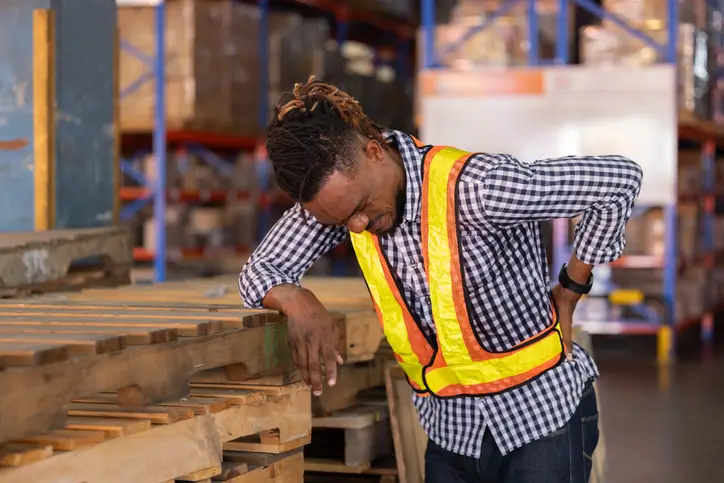Workplace Injuries in 2025
In 2025, workplace injuries continue to be a major concern across multiple industries, with construction work facing the highest risk. Back injuries, in particular, have reached crisis levels. Even with OSHA standards in place, many employees still experience insufficient support and protection during work hours, largely due to employer negligence, driving a steady rise in preventable workplace accidents.
The Stark Reality of Workplace Injuries
In 2016, the U.S. Bureau of Labor Statistics recorded 349,050 musculoskeletal disorder cases, resulting in 38.5% or 134,550 back injuries. The profession of nursing assistance, along with labor work, resulted in more than 10,000 back injury cases. Workplace injuries have shown an upward trend since 2025, as recent industry data shows these incidents exceed 400,000 reported cases per year. Workplace deaths caused by transportation accidents have increased, revealing the immediate requirement for extensive workplace safety measures.
The laws and regulations require every employer to provide workplaces free of known dangers. Employers must properly care for equipment while implementing safety standards, providing mandatory training and proper protective equipment to their personnel.
How Employers Put Workers at Risk
Employer negligence causes most workplace accidents that happen on the job. Workers face multiple dangers at their workplaces through the following actions of their companies:
Neglected known hazards result in many workplace accidents because employers do not handle dangerous conditions, including faulty machinery, unsafe scaffolding, and lack of fall protection systems.
Workers sustain many injuries because their employers do not supply necessary protective equipment, such as helmets, harnesses, respirators, and gloves.
Worker injuries become more likely when employers disregard training their staff or give inadequate training to their workers.
Some organizations force their staff to perform duties in hazardous environments by requiring them to meet unattainable deadlines, which drives them to take unsafe shortcuts.
Failure to do equipment maintenance results in equipment malfunctions, which consistently rank among the primary workplace injury triggers.
Common Causes of Back Injuries and How to Prevent Them
Construction sites represent one of the most dangerous environments for workplace back injuries. Chronic pain, together with mobility issues, arises from combining heavy physical work, repetitive stress, and improper body posture. Identifying back injury triggers enables workers to develop protective practices that minimize health risks for their spinal structure.
Lifting Heavy or Bulky Loads
Improper lifting produces severe spine strain, herniated discs, or muscle sprains.
Prevention: Bend knees, keep back straight, lift with legs.
Carrying Loads Awkwardly
Uneven weight distribution causes misalignment and muscle imbalances.
Prevention: Keep weight even, use lifting tools whenever possible.
Exerting Force on Heavy Loads
Pushing, pulling, or dragging heavy objects causes spinal damage.
Prevention: Use mechanical carts and maintain stable posture.
Manual Handling in Awkward Spaces
Restricted areas force abnormal body positions and increase strain.
Prevention: Create ergonomic workspaces, provide support tools.
Repetitive Tasks
Continuous motions like bricklaying and welding strain back muscles over time.
Prevention: Implement task rotation and scheduled breaks.
Poor Posture from Bending, Crouching, or Stooping
Frequent bending causes chronic lower back pain.
Prevention: Maintain proper posture, use assistive tools like knee pads.
Stretching, Twisting, and Reaching
Excessive or sudden movements strain spinal muscles and ligaments.
Prevention: Avoid overreaching and use proper body mechanics.
Prolonged Static Positions
Long periods of standing or sitting cause stiffness and fatigue.
Prevention: Take regular movement breaks and use ergonomic furniture.
Overexertion and Fatigue
Working beyond physical limits increases risk of injury.
Prevention: Respect physical boundaries and perform strengthening exercises.
Poor Ergonomics in Display Screen Equipment Use
Improper workstation setup creates back strain due to poor posture.
Prevention: Adjust workstation height, support chairs, and position monitors correctly.
Long-Distance Driving and Operating Heavy Machinery
Extended periods in unsuitable seats can lead to back strain.
Prevention: Adjust seat settings and take regular rest breaks.
How to Avoid Injuries in the Workplace?
Workplace injuries, especially those occurring in construction, need active prevention strategies from employers and workers to succeed.
Identify and Modify Risky Tasks
Workers should identify tasks that require heavy lifting, awkward postures, and repetitive movements. They should also use safer alternative tools like ergonomic equipment and automated processes to minimize strain during their tasks.
Involve Workers
Staff members should feel free to contribute their safety-related insights to the workplace. Safety measures remain practical and effective because regular feedback discussions with employees help evaluate their effectiveness.
Make Tasks Easier
Workers should use lifting devices, adjustable workstations, and scaffolding equipment to minimize physical stress at work. Workers who receive proper training on these tools will decrease their risk of injury.
Monitor for Early Signs
Observing discomfort signs includes noticing workers’ hesitation before performing tasks in addition to their frequent complaints. Supervisors need to conduct regular meetings with staff members to detect potential issues at work.
Foster Open Communication
Develop a workplace atmosphere that encourages staff members to report safety-related issues. The workplace environment should be supportive because it enables workers to focus on their health alongside their well-being.
Conclusion
Construction site injuries and workplace safety issues remain critical challenges affecting both daily tasks and overall performance. Protecting workers’ well-being requires understanding hazard origins and applying effective preventative measures. Employers must ensure safety through proper training, correct equipment use, and ergonomic solutions. Prioritizing a strong safety culture not only protects employees but also drives productivity, sustainability, and long-term industry success.





